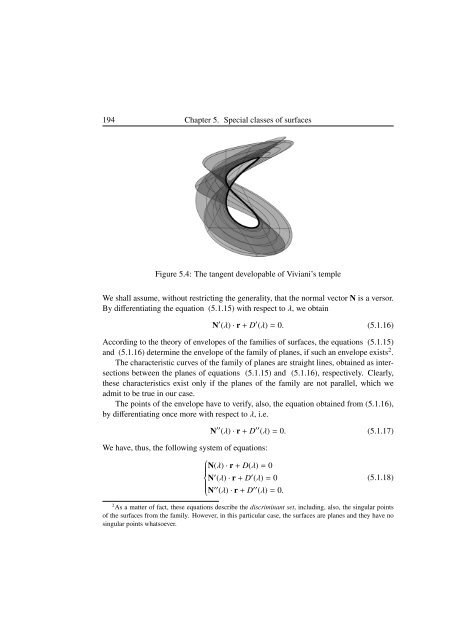Blaga P. Lectures on the differential geometry of - tiera.ru
Blaga P. Lectures on the differential geometry of - tiera.ru
Blaga P. Lectures on the differential geometry of - tiera.ru
You also want an ePaper? Increase the reach of your titles
YUMPU automatically turns print PDFs into web optimized ePapers that Google loves.
194 Chapter 5. Special classes <strong>of</strong> surfaces<br />
Figure 5.4: The tangent developable <strong>of</strong> Viviani’s temple<br />
We shall assume, without restricting <strong>the</strong> generality, that <strong>the</strong> normal vector N is a versor.<br />
By differentiating <strong>the</strong> equati<strong>on</strong> (5.1.15) with respect to λ, we obtain<br />
N ′ (λ) · r + D ′ (λ) = 0. (5.1.16)<br />
According to <strong>the</strong> <strong>the</strong>ory <strong>of</strong> envelopes <strong>of</strong> <strong>the</strong> families <strong>of</strong> surfaces, <strong>the</strong> equati<strong>on</strong>s (5.1.15)<br />
and (5.1.16) determine <strong>the</strong> envelope <strong>of</strong> <strong>the</strong> family <strong>of</strong> planes, if such an envelope exists 2 .<br />
The characteristic curves <strong>of</strong> <strong>the</strong> family <strong>of</strong> planes are straight lines, obtained as intersecti<strong>on</strong>s<br />
between <strong>the</strong> planes <strong>of</strong> equati<strong>on</strong>s (5.1.15) and (5.1.16), respectively. Clearly,<br />
<strong>the</strong>se characteristics exist <strong>on</strong>ly if <strong>the</strong> planes <strong>of</strong> <strong>the</strong> family are not parallel, which we<br />
admit to be t<strong>ru</strong>e in our case.<br />
The points <strong>of</strong> <strong>the</strong> envelope have to verify, also, <strong>the</strong> equati<strong>on</strong> obtained from (5.1.16),<br />
by differentiating <strong>on</strong>ce more with respect to λ, i.e.<br />
We have, thus, <strong>the</strong> following system <strong>of</strong> equati<strong>on</strong>s:<br />
⎧<br />
N(λ) · r + D(λ) = 0<br />
⎪⎨<br />
N<br />
⎪⎩<br />
′ (λ) · r + D ′ (λ) = 0<br />
N ′′ (λ) · r + D ′′ (λ) = 0.<br />
N ′′ (λ) · r + D ′′ (λ) = 0. (5.1.17)<br />
(5.1.18)<br />
2 As a matter <strong>of</strong> fact, <strong>the</strong>se equati<strong>on</strong>s describe <strong>the</strong> discriminant set, including, also, <strong>the</strong> singular points<br />
<strong>of</strong> <strong>the</strong> surfaces from <strong>the</strong> family. However, in this particular case, <strong>the</strong> surfaces are planes and <strong>the</strong>y have no<br />
singular points whatsoever.












